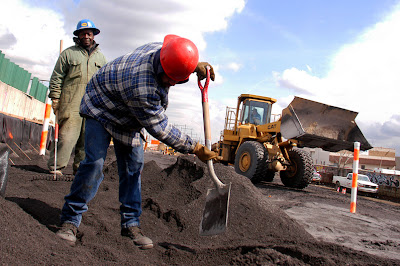
America’s infrastructure is crumbling. The economic “recovery” is sputtering. Hampered by historic levels of joblessness that shows no signs of abating, we inch towards the possibility of social unrest. At the same time, current conditions make infrastructure spending an attractive option. Construction materials, borrowing costs, and labor are cheaper than ever. Unemployment in the construction sector, hit hardest during the economic recovery, remains at around 17%. The way out is clear; it all fits together like a puzzle. We need massive fiscal stimulus dedicated to modernizing our nation’s infrastructure.
Last year, the Society of Civil Engineers gave our nation’s infrastructure a D grade. They estimated that more than 25% of the nation’s bridges are structurally deficient or functionally obsolete. Faulty pipes lose seven billion gallons of clean drinking water daily, and old sewage systems send billions of gallons of untreated wastewater into our waterways each year. Nearly half of American households lack access to public transit at a time when roadways are becoming more and more congested. With the SCE estimaing more than $2 trillion in repairs and upgrades are needed, Obama’s $50 billion infrastructure initiative, although a step in the right direction, isn’t enough. We need to both restore our current basic infrastructure and enact new public works projects to modernize our transportation systems.
In simple terms, the current (most recent?) recession was driven by a real estate bust. The collapse in real estate has led to an employment crisis within the construction sector. About 21% of the eight million jobs lost from December 2007 to December 2009 were in construction, and they haven’t returned. The Council of Economic Advisers estimates that unemployment among prospective infrastructure workers is currently 15%. Meanwhile, the gap between the rich and the poor in this country is widening (Wall Street bonuses and food stamp issues are both at an all-time high) and our middle class in disappearing. The construction sector, desperately in need of a boost, is full of these disappearing middle class jobs.
Meanwhile, perhaps the most compelling argument for massive infrastructure spending is the relative costs associated with such action at this time in history. Right now, we can get some real bang for our buck. Borrowing costs are at historic lows, construction materials are cheap due to the cheap dollar, and labor is relatively cheap due to the excess supply in the labor market. Whether you increase the deficit now or defer infrastructure improvements to the future, you are still imposing costs on future generations. Our infrastructure needs to be completely revamped at some point in the future, why not take this opportunity when it has the potential to stimulate growth and restore Americans’ sense of national pride?
The metric of note is the debt-to-GDP ratio, which right now falls around 90%. The New Deal played a key role in pulling our country out of the Great Depression, but actually an act of “accidental Keynesianism” was ultimately responsible: World War II. The war effort kick-started the moribund manufacturing sector and in the meantime raised debt-to-GDP to near 120%. In the process, a crazy thing happened: the debt-to-GDP ratio actually fell over time as GDP growth superseded debt costs. If you can create value for debt, it becomes a powerful tool for stimulating growth, I am not advocating we start another World War; the situation now is completely different. But, instead of increasing our debt-to-GDP in order to blow things up, we have the opportunity to make our America stronger by modernizing and improving our nation at its very foundations. High speed rail lines between major cities. Light rail trains to connect urban sprawlers with our disappearing industrial centers. Modernized airports to make air travel safer and more efficient. Improved roads to relieve congestion. Green energy initiatives to reduce our dependence on foreign oil.
The Federal Reserve seems hell bent on fulfilling its inflation mandate by flooding the market with liquidity, but the problem is not liquidity. No matter how hard you push on the string, it doesn’t matter. Demand is simply not there. The long-term damage that another round of quantitative easing could do to our currency greatly outweighs the (unlikely) potential outcome of a debt spiral. Right now, the economic recovery is nothing but fools gold, a house of cards if you will, propped up by the unsteady hand of Helicopter Ben. The Fed cannot pump money into the system forever, and the sooner the market detaches from the teat, the better.
Right now, we need our leaders to take bold and decisive action to create middle-class jobs and stimulate growth in our economy. The issue of fiscal stimulus has become a highly politicized issue, with Democrats and President Obama not willing to become (unfairly) labeled as the free-spenders at a time of fragile approval ratings and high-stakes elections. It is a shame that every issue in this country has become political, and at the heart of our problems is our flawed election system. But that is for another day. I hope that when we look back on this period in history, we see how bold visionary action prevented a period of prolonged economic stagflation, not how reckless and foolhardy monetary policy destroyed our currency. I hope that 30 years from now, we marvel at how modern and energy-independent our nation has become, not at how foolish we were not to miss a unique opportunity to move our country forward. Time makes heroes. I hope our leaders make the right choice.



